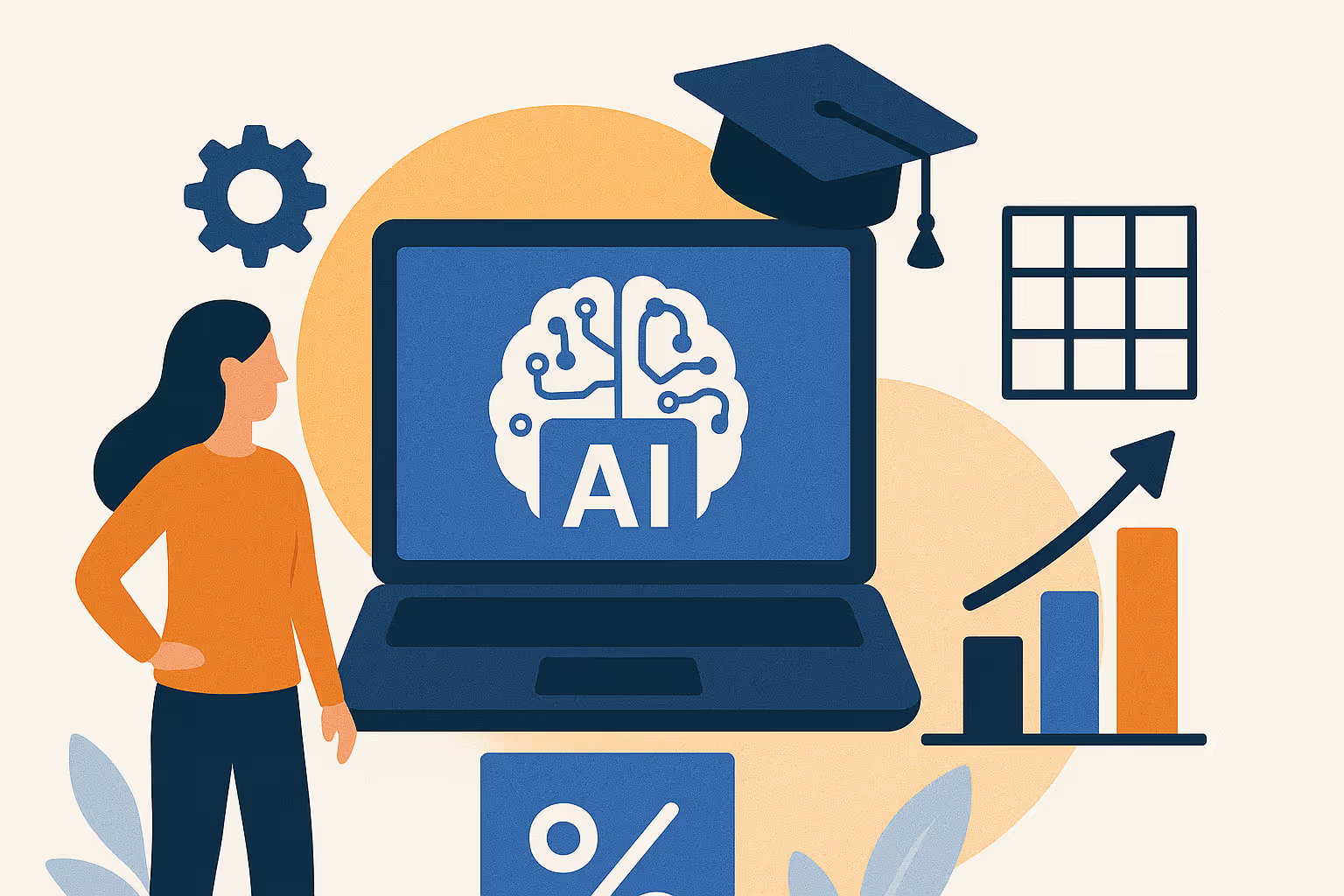About the Blog
Imagine cutting three months’ worth of work into a single week — without sacrificing quality. Or turning dry enrollment data into a vibrant, personalized roadmap that speaks directly to prospective students.
At the AI Engage Summit, Brian Piper, Director of Content Strategy and Assessment at the University of Rochester, shared how higher education professionals can integrate AI into content workflows to improve efficiency, engagement, and decision-making. With years of expertise in digital marketing and content optimization, Piper emphasized the transformative potential of AI for personalizing student experiences and streamlining institutional operations.
The AI Edge: What You Need to Know Now
- Automate Workflows to Save Time: Use AI tools like ChatGPT or Copilot to automate repetitive tasks, such as email drafting or report creation. Free up your time for strategic projects like campaign planning or student engagement.
- Make Communication More Personal: Build AI-driven personas using tools like ChatGPT to craft tailored messages for specific student groups. Ensure your communications resonate by aligning with their unique needs and preferences.
- Transform Data Into Actionable Content Ideas: Leverage tools like Perplexity AI to identify trending topics and student questions. Use these insights to create targeted blogs, videos, or resource pages.
- Multiply Your Content’s Impact: Repurpose one piece of content across multiple platforms using tools like Descript or Opus Clips. Turn a blog post into TikToks, Instagram posts, or LinkedIn updates in minutes.
- Address AI Resistance with Clear Benefits: Show leadership the risks of not adopting AI, such as falling behind competitors. Pair this with examples of success from peer institutions to make a strong case for integration.
Why AI is Essential for Higher Education Marketing
Brian Piper began his session with a compelling argument: AI is not only a tool for efficiency, but a necessity for staying competitive in higher education.
He shared how he has used AI tools to accomplish months' worth of work in a week, making it clear that these technologies are redefining what’s possible in higher education marketing.
For example, Piper showcased how custom GPTs could automate complex personal tasks, such as meal planning for his family, to highlight AI's versatility. Applied professionally, these tools streamline workflows, reduce cognitive load, and free up time for more strategic initiatives.
Curious about building your own custom GPT? Mallory Willsea will walk you through how to do it in 10 minutes or less.
Building Student-Centric Content with AI
Brian stressed the importance of understanding student needs through AI-powered personas.
By leveraging data and institutional strategic goals, AI can create nuanced personas that reflect the diverse needs of prospective and current students. This not only aids in tailoring content, but also opens doors to innovative solutions like virtual focus groups.
Institutions can even create custom GPTs based on these personas, using them as virtual consultants to optimize content like admissions pages. Piper explained how his team uses AI to run hypothetical scenarios, such as asking potential students what content gaps exist, enabling real-time adjustments to meet student expectations.
Repurposing and Redistributing Content
A central theme of Piper's presentation was the need for content redistribution across platforms.
With Gen Z and Gen Alpha increasingly searching on social platforms like YouTube and Reddit, higher-ed marketing teams must optimize their content for these channels. Piper introduced tools like ChatGPT, Opus Clips, and Descript that turn a single long-form piece of content into multiple bite-sized, platform-specific formats.
For example, a podcast episode can be transformed into TikTok videos, Instagram reels, or blog posts. Piper also shared how the Marketing AI Institute uses AI to create 20-30 pieces of content from a single podcast episode in just hours, a process that would traditionally take days.
Overcoming Resistance to AI Adoption
Resistance to AI remains a barrier in many institutions, but Piper offered a strategic approach: focus on the risks of not adopting AI.
He outlined potential pitfalls such as falling behind competitors, missing enrollment opportunities, and losing employees who want to innovate with AI. By forming an AI committee at his institution, Piper has fostered a culture of collaboration and exploration. The committee created guidelines, identified pilot projects, and now operates as a community of practice, continually sharing insights and innovations across teams.
AI Tools to Watch
Piper highlighted several AI tools that higher education marketers can integrate into their workflows:
- Perplexity AI: For research and content ideation, providing reliable, cited sources.
- Descript: To edit and repurpose video and audio content efficiently.
- HeyGen: To create multilingual AI-driven video avatars, useful for training and student engagement.
- Runway AI: A text-to-video tool poised to revolutionize content creation.
- Opus Clips: For generating short, engaging clips from long-form video content.
AI as a Tool to Enhance Humanity
Despite fears that AI could replace human roles, Piper argued that it allows professionals to focus on the creative and relational aspects of their work. By automating mundane tasks, institutions can enhance one-to-one relationships with students and ensure that every interaction feels personalized and thoughtful.
Navigating Limited Staffing, Tight Budgets, and Shifting Student Demographics with AI Solutions
Higher education institutions face mounting pressures from limited staffing, constrained budgets, and the need to adapt to rapidly shifting student demographics.
AI-powered tools are transforming these challenges into opportunities by streamlining operations and improving decision-making. For instance, AI-driven chatbots reduce the burden on overworked staff by handling routine student inquiries 24/7, freeing up human resources for more complex tasks. Advanced data analytics help institutions allocate their budgets more effectively, identifying high-impact strategies for student recruitment and retention. Moreover, AI solutions provide deep insights into changing student preferences and behaviors, allowing universities to create personalized experiences that resonate with diverse and evolving student populations.
Start Transforming Your Strategy Today
Brian Piper's presentation is a call to action for higher ed professionals: embrace AI now or risk falling behind.
Whether it's through improving efficiency, personalizing student engagement, or optimizing content performance, the tools and strategies shared at the AI Engage Summit provide a roadmap for leveraging AI's full potential.
Explore all of the AI Engage Summit Sessions featuring Brian Piper and other Enrollify creators such as Jenny Li Fowler and Allison Turcio to gain even more actionable insights.
Make sure to check out Brian’s podcast, AI For U, to unlock the potential of AI at your institution with practical insights and easy-to-implement use cases tailored to you.
FAQs:
What are the ethical considerations when using AI in higher education marketing?
Ethics training in higher education must emphasize robust data privacy practices, including anonymizing sensitive information to protect individual identities while enabling actionable insights. Institutions should enforce strict access controls, ensuring only authorized personnel can handle data, and regularly update privacy policies to comply with regulations like GDPR and FERPA. By embedding these practices, higher education can safeguard student trust and ensure ethical use of data in decision-making.
How can small teams with limited budgets start integrating AI tools?
Start with free or low-cost tools like ChatGPT (free version) and Perplexity AI, focusing on automating time-consuming tasks like content ideation or email drafting.










